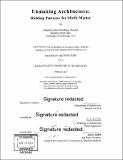| dc.contributor.advisor | Sheila Kennedy. | en_US |
| dc.contributor.author | Marshall, Daniel Jonathan Meiklejon. | en_US |
| dc.contributor.other | Massachusetts Institute of Technology. Department of Architecture. | en_US |
| dc.date.accessioned | 2020-03-09T18:38:54Z | |
| dc.date.available | 2020-03-09T18:38:54Z | |
| dc.date.copyright | 2019 | en_US |
| dc.date.issued | 2019 | en_US |
| dc.identifier.uri | https://hdl.handle.net/1721.1/124040 | |
| dc.description | Thesis: M. Arch., Massachusetts Institute of Technology, Department of Architecture, 2019 | en_US |
| dc.description | Cataloged from PDF version of thesis. | en_US |
| dc.description | Includes bibliographical references (pages 86-87). | en_US |
| dc.description.abstract | This project provides techniques for arranging materials after the demolition and unmaking of architecture. Rather than down cycling concrete into low value aggregate, melting float glass into opaque bottles or grinding up street trees into mulch, methods are shown for this material to be indexed, re-machined and re-arranged into new assemblies. These assemblies are conceived of as holding patterns; an indexed library of materials that are put into useful architectural arrangements, but ready to be disassembled towards some future use. These holding patterns are as infil to the city rather than landfil beyond. For instance, the rubble from the current demolition of Plattenblau buildings in the post-coal mining cities around Berlin can be reconfigured to meet new housing demands. Irregular pieces of glass and the chaotic branches of felled street trees can be carefully fabricated into greenhouse and light manufacturing spaces. While recycling is typically understood as a way to achieve stasis the holding patterns are transitory monuments looking to reconstruct along an alternative trajectory. Rather than building for sixty-year life spans, the project offers an imagination of constructions that can learn from the carcass of past buildings. Based on rough estimates' 2016 could be the first year where there exists more than one trillion tons of concrete on earth. More that the total weight of living trees on the planet.' This thesis begins develop new aptitudes for re-fitting missfit material rather than consuming ever more. | en_US |
| dc.description.statementofresponsibility | by Daniel Jonathan Meiklejon Marshall. | en_US |
| dc.format.extent | 105 pages | en_US |
| dc.language.iso | eng | en_US |
| dc.publisher | Massachusetts Institute of Technology | en_US |
| dc.rights | MIT theses are protected by copyright. They may be viewed, downloaded, or printed from this source but further reproduction or distribution in any format is prohibited without written permission. | en_US |
| dc.rights.uri | http://dspace.mit.edu/handle/1721.1/7582 | en_US |
| dc.subject | Architecture. | en_US |
| dc.title | Unmaking architecture : holding patterns for misfit matter | en_US |
| dc.title.alternative | Holding patterns for misfit matter | en_US |
| dc.type | Thesis | en_US |
| dc.description.degree | M. Arch. | en_US |
| dc.contributor.department | Massachusetts Institute of Technology. Department of Architecture | en_US |
| dc.identifier.oclc | 1102595328 | en_US |
| dc.description.collection | M.Arch. Massachusetts Institute of Technology, Department of Architecture | en_US |
| dspace.imported | 2020-03-09T18:38:52Z | en_US |
| mit.thesis.degree | Master | en_US |
| mit.thesis.department | Arch | en_US |
